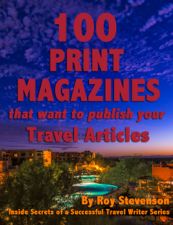The Best DSLR
for Travel Writers
By Linda Popovich
What's the best dSLR camera for travel writers? That's a good question, because these days you have so many camera options. Let's start with reasons to upgrade your current camera.
Maybe you've decided your smartphone or your point-and-shoot camera won’t meet your needs anymore. Your images aren't good enough for print magazines. When this happens, most travel writers upgrade their camera.
Here are the main reasons to upgrade your camera:
- Your magazine editors are rejecting your photos because of poor image quality
- Your photos and action shots are blurry
- Your JPEG images are dark or grainy and can’t be adjusted
- Your need a better lens than the one on your smartphone or point and shoot
If it's finally reached the point that you need to upgrade, you have 2 options: upgrade to a dSLR or upgrade to a mirrorless system.
Here are four good reasons to choose a dSLR over a mirrorless camera:
- dSLRs have better ergonomics than smaller cameras - they're simply easier to grasp because they're a little bit bigger
- Many dSLRs are just as light as mirrorless models
- Battery power on dSLRs is significantly better - it's common to use only one battery for an entire day
- You can get an inexpensive beginner/intermediate model for about the same or less than a mirrorless price
In addition to the bewildering variety of camera brands and camera bodies, there’s also a huge selection of lenses available for dSLRs. The best dSLR for travel consists of a body and a lens. With so many options available, it’s hard to know where to start.
To take the mystery and fear out of buying a dSLR, I've got some recommendations:

Buy a lightweight camera body
DSLR’s come in consumer, enthusiast, and professional categories. Your first dSLR camera should be from the consumer and enthusiast categories. This comes with a couple of advantages: they’re lightweight and great for travel, and they cost considerably less than the high-end models.
Be warned: even the consumer dSLR models are finely honed and come with a multitude of features – probably more than you’ll ever use. Don’t let this deter you. It gives you room to grow. You can always experiment or take photography courses at your local community college to learn more and network with others learning about their camera.
Although consumer DSLR’s are lightweight, they’re still very durable, and great for travel. If you take reasonable care, your camera body will last several years.
All major brands offer consumer quality models, but for the best dSLR stick with a major brand like Nikon or Canon. The reason I suggest buying a major brand is that you want to feel certain they’ll still be around in a few years when your camera needs parts or service, or when you’re ready to upgrade.
Your first step is to go to a camera store and play around with several models to decide which one you like best. Note how it feels in your hands and if it feels ‘balanced’. Look through the viewfinder. Play around with the dials. Look at the menu and the screen. Ask questions about its main features.
I’m partial to Nikon cameras because I think they’re more intuitive than some other brands. But you shouldn’t necessarily buy what somebody else likes. Buy the one that you like best.
As long as you stick with one of the major brands, your choice of "best dSLR" will be fine. Canon, Nikon and other major brands put a lot of research and development into their cameras and deliver quality products. None of them are a bad choice.
Buy the body only (without a lens)
When you decide to make your purchase, buy the “body only” option. Do NOT buy a camera/lens combination.
Lenses that come bundled with the camera are known as “kit” lenses. Many beginners buy the body/lens combo and soon find out that the lens doesn’t suit their needs. Inevitably, “kit” lenses are a waste of money. So the best dSLR for your money is "body only".
In addition, kit lenses tend to be lower quality and you won’t recoup much on your investment if you try to sell them. Buying a camera with a kit lens is a typical beginner’s mistake.
The lens is more important than the camera body when it comes to image quality and versatility. Although I’m suggesting you purchase a lower end camera body, you should still buy a high quality lens.
Think of your camera body as something that you upgrade every few years as technology improves. Think of your lens as an investment that you’ll continue to use as you ‘grow’ into newer camera bodies.
Even when you ditch the old camera body, you can usually keep using the same lenses as long as you stick with the same manufacturer. You’re better off buying the camera body only, and then purchasing your lens separately.
Buy a high quality, versatile travel lens
As a travel writer and photographer you’ll want to travel as light as possible, so your goal is to use one lens that will serve you well in the most situations.
You’ll need a wide-angle lens for landscapes, cityscapes and interiors. You’ll need a telephoto lens to capture faraway objects and buildings. Close up people shots are obviously important for travel stories, too.
But you don’t want to have to change lenses for every situation. Struggling to change a lens will cause you to miss that special moment. Your shot will disappear.
Fortunately, you can find a single lens for all these situations.
For several years now, the Nikon 18-200 mm lens has been rated as the best DSLR travel lens on the market. Tamron has also entered the market with a lightweight, versatile lens, the Tamron 18-270 mm. Canon also offers an 18-200mm lens for their cameras.
Any of these lenses will pair well with your camera body for travel photography, and they are offered at very competitive prices.
Here are my recommendations for the best dSLRs if I was purchasing one for the first time today. I've listed an entry model and an enthusiast/intermediate model for both Canon and Nikon.
Any of these options are a good starting point:
|
|
Nikon D3500 The Nikon brand is among the best dslr cameras you can buy. I’ve been using various models of Nikon since 2002 and they’re still my favorite cameras. I think it’s the most intuitive brand out there. The D3500 is simple enough to use immediately, has room to grow, and is cheap enough that you can upgrade later and not feel bad about the money you spent. The image quality is fine 24.2 MP. It has a responsive autofocus good for capturing action and has been called the best dSLR camera for beginners. And the body is lighter than most mirrorless models. It has RAW image capture and delivers “brilliant results on a budget”. Weight (body + lens) = 2.1 lbs. |
|
|
Recommended lens for the Nikon D3500 and Nikon D5600 Nikon AF-S DX 18-300mm |
|
|
Nikon D5600 Weight (body + lens) = 2.2 lbs. |
|
|
CanonEOS Rebel SL3 This made the best dSLR list because it is a compact, friendly camera with good performance. It's forbeginners or enthusiasts. The Canon EOS Rebel SL3 is a step up from the base model, but is even more compact. It's Canon’s lightest DSLR, so it’s great for travel (but the Nikon D3500 is even a few ounces lighter.) It has a 24-megapixel APS-C sensor and battery life is rated at 1,600 shots per charge when using the optical viewfinder. That's great compared to mirrorless models. If you want compact, a great battery life and a good price, it's a great buy. It's lightweight at just under 1 lb. And with the travel lens recommended below, it only weighs 2.3 lbs. |
|
|
Recommended travel lens for Canon SL3 and Canon T7i Canon EFS 18-200mm standard zoom lens |
|
|
Canon EOS Rebel T7i DigitalTrends.com rated the Canon EOS Rebel T7i the best DSLR for beginners overall. They were impressed with its performance, and mentioned autofocus, shooting speed, and battery life in particular. They also say it has one of the most approachable user interfaces of any camera. There's room to grow because it goes beyond the basics, so you can enjoy it long after you master the basics. It's light at only 1.17 lbs. With the recommended travel lens (above) it comes in at a total of 2.5 lbs - similar to most mirrorless models. |
Disclosure: Most of the links on this page are affiliate links. If you click on a link and make a purchase we will receive a small fee.
These are just a few of your options - but they're a good starting point if this is is your first dSLR.
Roy uses an older model Nikon D5100 and loves it. For years he used a Nikon 18-200mm lens and was very happy with it. His travel photos are beautiful and the magazine editors he works with are happy with his images. He's currently using the Nikon 18-300 lens recommended above.
Roy’s not the
least bit interested in upgrading to the newest model just to get a few
new bells and whistles. And he's sticking with a dSLR because of the grip - it's comfortable in his hands. Maybe that will change someday, but not now.
 These are your 3 camera choices for images appropriate for print quality: point and shoot (left), a mirrorless (middle) and a dSLR (right). Sizes differ depending on brand and model. Which one will you choose?
These are your 3 camera choices for images appropriate for print quality: point and shoot (left), a mirrorless (middle) and a dSLR (right). Sizes differ depending on brand and model. Which one will you choose?Accessories You'll Need:
1. Memory cards
You can own the best DSLR in the world, but you won't have any images without a supply of memory cards for storage.
You’ll need several memory cards. I always pack extras, even if I don’t use them. Always travel with more cards than you think you need. They’re small, and it’s much better to have too much storage than not enough.
I’d suggest purchasing two or three SanDisk Ultra 32GB cards to get started. Purchase more if you’re planning an extended international trip.
2. Extra battery
Always buy an extra battery for your camera. There's nothing more frustrating than having a dead battery in the middle of an exciting trip. Even the best dSLR battery eventually runs out of power. You always need a spare.
Keep your extra battery charged and in your camera bag (or pocket). When you travel, charge your batteries at night so you start each day with a fully charged battery in your camera, and a fully charged spare in your pocket.
3. UV filter to protect your travel lens
This name is deceptive—it comes from film days when UV filters blocked UV light and removed the blue cast from images. That’s no longer important, but the name remains (to confuse the rest of us).
If UV filters are not necessary to block UV light, why should you use one? A UV filter on the front of your travel lens protects your lens from damage caused by rough handling, and also protects your lens from scratches.
A couple years ago Roy lifted his camera out of his bag to take some shots at a castle in Wales, and found his UV filter completely shattered. Since he’s very careful with his camera gear, he could only trace it back to someone bashing his bag while trying to fit theirs into the overhead compartment on the plane.
He removed the broken filter and carefully disposed of it, then proceeded with his shoot. All went well. The good news is he only had to replace the $45 filter - not the expensive lens. So the filter did its job protecting the lens and we replaced it when we got home.
It’s also easier to clean a UV filter than it is to clean your lens because it’s flat. Buy a high quality filter and use it to protect your lens and keep it clean.
A couple good choices are:
Hoya 72mm UV Multi-Coated filter (less than $40), and
B+W 72mm 72mm Clear UV Multi-Resistant filter (less than $50).
Either of these are a good choice. Don’t buy a cheap filter.
And make sure you buy the right size filter for your lens. The filters shown here are for a 72mm lens - check your lens size before you buy. (For example, the Tamron 18-270mm lens has a 62mm lens opening so you will need to buy a smaller UV filter.)
4. Camera bag
Camera bags protect your camera from rough treatment. The type of camera bag you choose is a matter of personal preference. I suggest something small and well padded.
Make sure your bag has extra pockets for memory cards, batteries, and a micro-fiber cloth for cleaning the front of your lens.
A small bag is great for travel since it’s light and easy to carry, It also fits into a larger bag or backpack for more protection when you’re on the plane and transporting your bags in taxis, buses and trains.
Never, ever put your camera bag into checked baggage. Always keep it with your carry-on luggage.
DSLR’s versus Mirrorless Cameras
If you're looking for the smallest possible option for travel, the best DSLR for you may not be a DSLR at all - it may be a point and shoot camera or a mirrorless camera.
Mirrorless cameras have gained in popularity. These cameras are smaller and lighter than dSLR’s, yet they produce high quality images.
The best mirrorless cameras are great for travel because your gear is lighter. They’re less conspicuous out in public because of their smaller size. Most are better for video, if that’s your thing.
The current advantages of the best dSLR over most mirrorless cameras is:
- greater variety of lenses available
- dSLR’s are better in low light
- dSLRs are better for action shots such as sports, wildlife, and other fast-moving subjects
- dSLRs are easier to handle / grip
- dSLRs have better batteries
Roy is still happy with his dSLR and doesn't plan to replace it anytime soon. Image quality is excellent, and it's the right size for his hands. He upgraded his lens this year to an 18-300mm so he plans to use it until something breaks.
But if you don't own a dSLR, you might want to check out this article for the best mirrorless camera for travel before making your decision.
So, what's the best DSLR for travel writers?
If you've decided a dSLR is right for you, it’s as simple as choosing a good camera body and a versatile lens. The best dSLRs are an easy way to get high quality images for your travel stories, and if you choose the right models you'll also travel light to your destinations.
Related articles that will interest you:
How Travel Photographs Will Help You Sell More Travel Stories
The Best Mirrorless Cameras for Travel Writers
The Best Point and Shoot Camera for Travel Writers

Linda Popovich is a freelance travel photographer based in the beautiful State of Washington when she's not living somewhere in SE Asia. Her images have been published in more than 58 regional, national, and international print magazines and also in online travel magazines. She’s also the Editor and Publisher of PitchTravelWrite.com.
IF YOU ENJOYED THIS POST, GET UPDATES. IT'S FREE.













